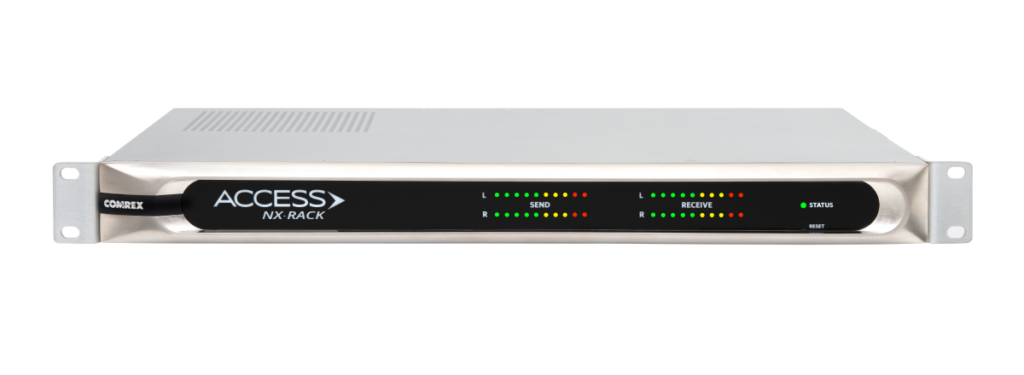For the last 30 years Integrated Service Digital Network (ISDN) has been the core technology for remote audio broadcast links using digital telephone services. This technology relies on digitising and data compressing audio to allow ‘broadcast quality’ contributions to be transmitted over the relatively low bit rate of the ISDN paths. While ISDN links provide the required reliability, quality and low latency, there have always been complexities with ISDN. Issues include non-interoperable compression algorithms and numerous IDSN standards, and this has led many organisations to be cautious of ISDN. The rental of the ISDN lines also had significant costs. Now the broadcast industry is faced with the issue that Telcoms companies plan to stop their ISDN service in 2025.
A new generation of IP Codec are available where the data path is the internet. These products offer many advantages compared to ISDN and other various technologies that have been developed to provide the reliability and low latency required by broadcast applications, even when using the public internet. At the forefront of this technology is Comrex who have unparalleled experience with developing and manufacturing a range of products using IP technology.
Whether you are replacing ISDN equipment or upgrading existing IP capabilities, Comrex have a range of solutions to suit all applications and with their CrossLock (see tech note 1) and Switchboard (see tech note 3) technologies, quality, reliability, and ease of use is assured. This article will look at two common use cases for this secure, reliable, and user-friendly technology.
BT have been vocal and open about phasing out ISDN lines and have said that they will be switched off completely in 2025. While many have already made the switch to IP, there is ISDN equipment in use today that will be obsolete in 2025. Sports commentary is an area where ISDN is still common although are already newer stadiums without ISDN infrastructure. This makes workflows difficult for visiting teams, commentators’ using ISDN equipment, who need to find alternative ways of connecting back to their AV centres.
A solution for this issue is the Comrex ACCESS NX Portable. With two microphone and headphone connections and an easy to use touch screen interface makes it the ideal solution for commentators and if more connections are needed, the optional Mixer adds an additional four microphone and headphone connections. An IP connection is achieved via Ethernet, Wi-Fi and optional one or two 4G modems. Further, CrossLock Technology (see tech note 1) can utilise more than one of these connections to ensure maximum reliability.
Then back at the opposing team’s AV centre, a rack mount ACCESS NX Rack connects the to the IP stream and interfaces to analogue, AES3 or AES67 equipment. So that viewers can enjoy commentary from whoever they are supporting.
Another common application for ISDN lines was connection between remote voiceover studios and broadcast centres for continuity announcements. The ACCESS NX Rack is the ideal IP solution for this application. Like the Portable, it can utilise Wi-Fi and 4G as well as Ethernet with CrossLock (see tech note 1) for secure and stable broadcasting. The HotSwap (see tech note 2) feature can switch networks only if the primary one fails providing much needed redundancy. If multiple connections are needed, Comrex have the ACCESS MultiRack which houses five full-duplex IP audio codec connections in a 1U enclosure. The audio connections for codecs 2-5 are via AES67 supporting the latest standards. The Comrex rack codecs are controlled via a web browser which means you can log-in from anywhere to manage settings, adjust controls, and monitor connections. Monitoring and control can also be achieved and are made easy with the Codec Commander application and FieldTap iOS/Android app. The Fleet Commander application takes care of monitoring for multiple codecs at once.
Contact HHB to find out more about the technology behind the products and best combination for your applications.
Tech Note 1
CrossLock gives users the ability to use multiple IP networks together simultaneously. When a new network is introduced, Crosslock will immediately evaluate how much bandwidth is available, while factoring in latency and jitter information, and combine the two connections to take advantage of all available bandwidth.
More than just combining networks, CrossLock can also monitor and dynamically adjust how much of your stream is being placed on each network, in real time. When necessary, CrossLock can apply appropriate error correction, recovery, or concealment techniques. And when a network becomes unusable, CrossLock can isolate it, without any user intervention.
Tech Note 2
HotSwap allows users to back up studio-to-transmitter links (STL) or other dedicated links with a wireless modem.
HotSwap lets users select a network that will only be engaged if the primary network fails. The system will warn of this status with a contact closure, and automatically fallback to the primary once it’s restored. Fall-over to backup happens in a matter of seconds, and fallback is seamless.
For ACCESS codecs, any supported modem can be used as a back-up.
Tech Note 3
Switchboard is a feature that allows users to bypass common IP networking snags (like private LANs and firewalls) by routing data through a private server maintained by Comrex.
Switchboard within the hardware codec enables the following functions:
- Comrex codecs can sync with a cloud based server and deliver status information
- Comrex codecs can determine their public IP address and the type of any NAT-style router ahead of the codec, and display that information to the user
- Comrex codecs can display presence, status, NAT info and IP addresses of other codecs within the same fleet
- Comrex codecs can share this information with codecs outside the fleet (Shares)
- Comrex codecs can take instruction from the server on how best to traverse NATs when placing a call between two codecs
Reduce the strain on your IT department and worry less on remote day. Switchboard makes it easier to log on to unfamiliar Wi-Fi networks, like those you might encounter in hotels, schools, and wherever else you might do a remote.
Switchboard is included in the purchase of any ACCESS codec.





